Last Updated on April 18, 2022
Wheels can become misaligned if the vehicle is suddenly jarred, such as by driving over a pothole or an object in the road. Parts in the wheel assembly and suspension can also wear and shift to cause noticeable symptoms that it’s time to realign the wheels.
A properly aligned vehicle will perform better and more efficiently. If you must make a fast turn or dodge something quickly that’s on the road, a wheel alignment could be the very thing that saves your life.
6 Common Bad Wheel Alignment Symptoms
Sometimes underinflated tires can cause problems which could also be caused by misaligned wheels. Check the tire pressures first, and if those are within normal limits, then it may be time to have your wheels realigned. The following are symptoms of a bad alignment.
#1 – Vehicle Pulls to One Side

Check your alignment when driving on a straight road with little traffic: remove your hands from the steering wheel and let the vehicle guide itself on the road. If it swerves or drifts toward one particular side, place your fingers back on the steering wheel and lightly maintain control of the steering to stay on the road.
When the vehicle is driving straight once more, try the test again. If the vehicle still veers toward the side, then the wheels need to be realigned. The more it pulls out of a straight line, the worse the alignment is.
If you don’t address the problem, it will be harder to drive straight and you may even cross over into other lanes on the road if you don’t maintain a firm grip on the wheel at all times. If you have this problem with your vehicle, take it to an auto mechanic and have an alignment done right away.
Note that the crown of a road may cause your vehicle to pull to one side as well, since the center of the road is higher than the shoulder.
#2 – Uneven Steering Wheel
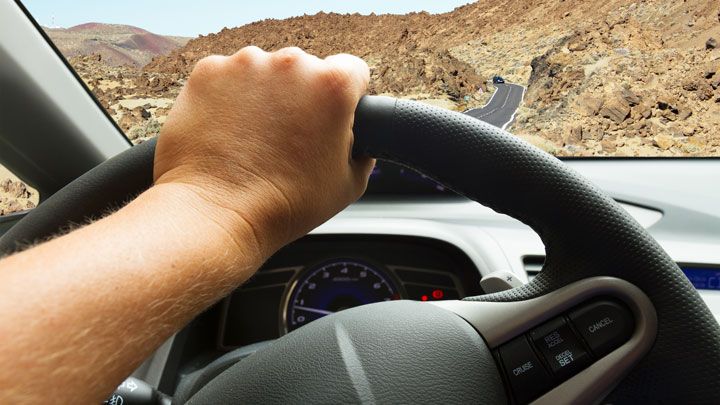
Whenever you’re driving down a road that is completely flat and straight, the steering wheel of the vehicle should remain straight and not off-center.
An easy way to check this is to look at the emblem in the center of your steering wheel. If the emblem remains level while driving straight, then the steering wheel is centered.
But if the emblem tips a couple of degrees off level in any direction, then the steering wheel is uneven and the vehicle needs a wheel alignment right away. Once the vehicle is realigned, the steering wheel will remain centered and the vehicle will be much easier to control.
#3 – Loose Steering
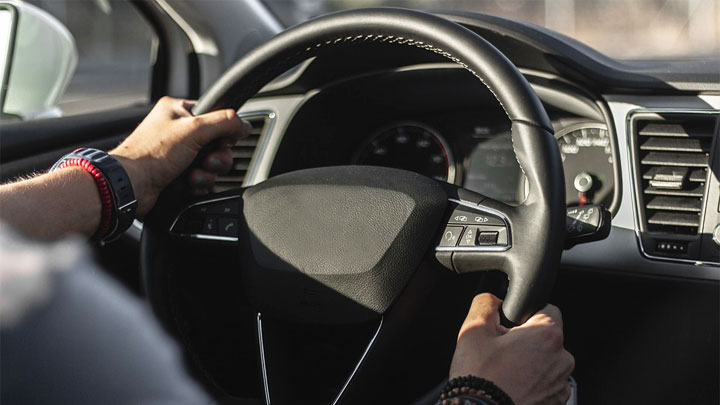
A sloppy, or loose, steering wheel can be very dangerous as it can cause a decreased response time when turning. This can be caused by misaligned wheels and should always prompt you to have the vehicle checked out by a mechanic.
Related: Causes of a Steering Wheel That’s Hard to Turn
#4 – Steering Wheel Vibrates
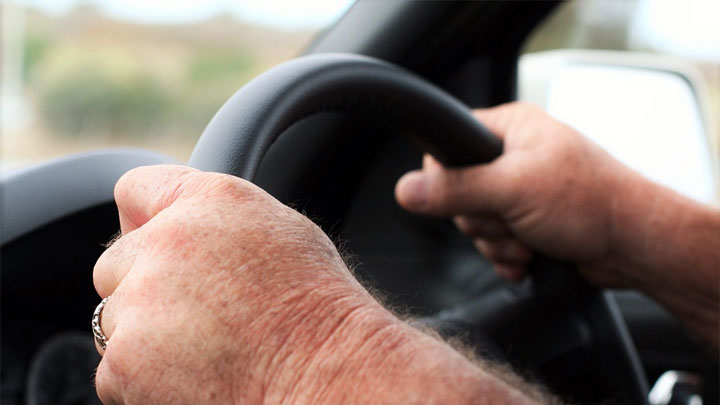
A steering wheel that vibrates while the vehicle is in motion is likely due to misaligned or unbalanced tires. However, vibration from a steering wheel could also indicate other more serious problems. A professional can determine the cause of the vibration.
#5 – Uneven Tire Wear
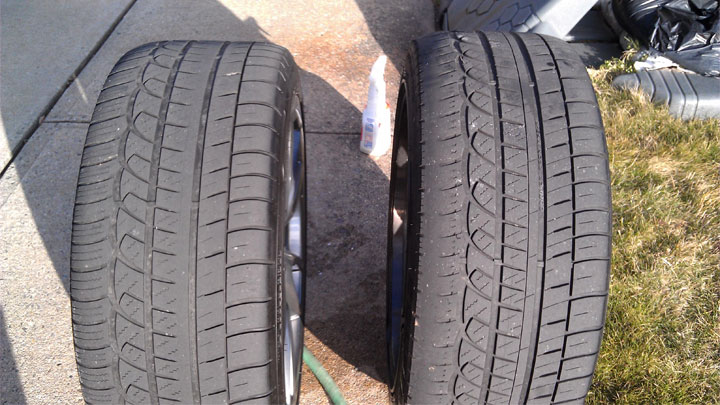
If you notice that the treads on certain tires of your car are wearing out faster than others, the wheels may be misaligned. This can be in the form of excessive outer tire wear, excessive inner tire wear, or tire scalloping.
Measure the tread depth on both sides of each tire with a tread depth meter for greatest accuracy. Wheels that are properly aligned will all have the same rubber depth on the tires.
#6 – Tires That Squeal

As tires wear unevenly due to a misalignment, they can start to squeal as the vehicle accelerates or makes turns. Squealing can be caused by other things such as worn brake pads, so have the vehicle checked if you notice this symptom.
Types of Alignment
Wheels can become misaligned in many different ways and directions. Here are 3 of the most common types of alignments done.
Camber

Camber measures the angle of the wheel when looking straight on at the car from the front. If the wheel leans towards the car with the bottom of the wheel farther away from the car than the top, that is a negative camber. A wheel that leans away from the car has a positive camber.
Toe

Toe refers to where the front of the wheel is relative to the back of the wheel. If the front of the wheel points in towards the center of the car, this is toe in, or positive toe. If the front of the wheel points out away from the center of the car, this is toe out, or negative toe.
This type of alignment is adjustable on all cars.
Caster

The caster of the wheel measures the angle of the pivot which turns the wheel, while looking at the wheel straight-on from the side of the car. This pivot connects to the wheel by two points, the upper and lower, which should be stacked on top of each other.
If the upper point is leaning towards the back of the car, it’s a positive caster. If the upper point leans towards the front of the car, the caster is negative.
Misaligned caster causes the steering to feel too heavy or too light. This usually cannot be adjusted on front wheel drive cars, so in these vehicles the suspension may be damaged if the caster is off.
Why It’s Important to Fix an Alignment Problem Right Away
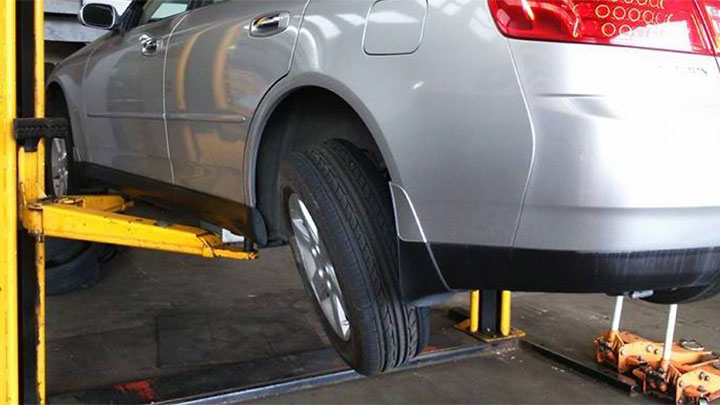
These symptoms of misalignment can be easy to ignore, perhaps because drivers think it’s no big deal or don’t want to spend money on the cost of an alignment. The problem is that the longer you put off getting a realignment, the more damage will be done to the tires and vehicle.
Poor gas mileage is prevalent on vehicles with misaligned tires because the vehicle has to work harder to go where it should and thus consumes more gasoline. Also, tires that you bought with a lifetime warranty often have fine print requiring regular alignments.
Do yourself a favor and take your vehicle to a mechanic or alignment shop if any of these symptoms are present. Wheel alignments are not very expensive when you consider the alternative of damage repair, increased fuel costs, and early tire replacement.

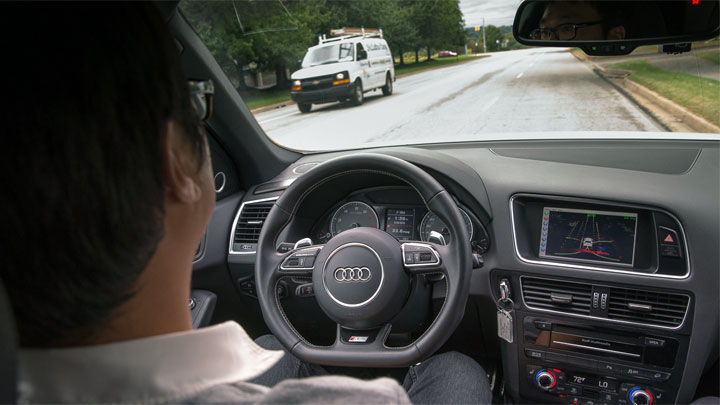
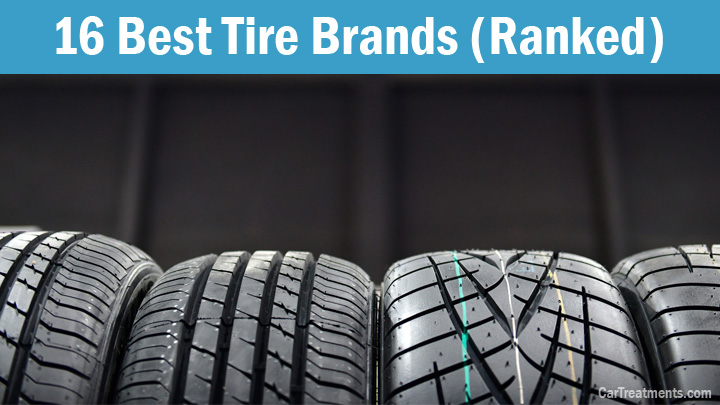


03 expedition when drive get vibration in wheel
and hear thumping sound from Newest tire driver side
not sure what it is
Make sure the lug nuts are on tight! Unlikely if it’s a newer tire but a broken belt inside the tire or a flat spot can be the problem. Otherwise, bad wheel bearings may be the cause as well.
Had my car aligned with brand new tires and its vearing from one side to the other? They say its because of my strut bearing. Does this make sense?
Yes, suspension components can definitely contribute to alignment issues.
I’ve had 4 alignments and front shocks replaced all in last 6 months. Still feels like I can’t control steering. Almost a scary feeling. What else could be causing me to drift side to side in my lane?
I would look at tie rods, ball joints, and wheel bearings (in that order). Sticky brake caliper is unlikely but also possible. If something is damaged in the suspension, it will simply keep throwing it out of alignment until fixed. Is the place that’s doing the alignment not checking any of these components?
maybe even a bad rack and pinion it will also cause steering problems
old post I’m sorry! Hope it still helps
I had two new rear tires put on a week ago, I don’t know if you can get a rear alignment but while driving it feels like I’m losing control of my car when I get up to about 70mph. It seems as if I can’t control the wheel. Please tell me what’s wrong. I had a oil change also. Its very scary. They said they aligned the front
There are other problems that could cause this. You could have worn suspension bushings, a bad wheel bearing, a loose tie rod end, a bad steering rack, or a few other possible issues. When you feel like you’re going to lose control it’s often a result of a problem on the front axle, but not always. I recommend you take your vehicle to a mechanic to get it checked out as soon as possible. Make sure you can describe the problem in as much detail as possible.
usually the rear tires have minor effect on the steering. However, it sounds like there is ply separation or improper balance in your rear wheels.
I would first look at all your tires, check for pressure and balance (make sure that the balance clip has not fallen off.) Then check all tires for ply separation – You could have a dud tire.
You never know what they’re doing to your car when it’s in the workshop!. I sometimes think they splve one problem, and deliberately cause others!. I absolutely hate having to take my car into the workshop, and wherever possible avoid it!
Depends on the shop. There are some very good and trustworthy shops out there.
What was the result of this? i recently had both rear tyres changed and the same thing happens , it’s like driving a boat
I have a 2009 Ram with 44,000 miles replaced all 4 tires recently and 4 wheel alignment also they found a loose tie rod and replaced it left shop noticed truck pulled to the right returned a couple days later they rechecked alignment found it was according to specs but did a slight adjustment returned once again since they had not installed new valve stems old metal ones had cracked they rechecked alignment once again made no adjustments I think they swapped the front tires now she pulls to the right before the alignment the truck tracked straight I was told when I come in for a tire rotation in 6000 miles this may correct the problem. Tires causing the problem ?
I’ve had control arms, drop links and front suspension replaced, wheels aligned, car runs out of alignment within an hour, take a corner and a few seconds later wheels pull quickly to 1 side or the other
Same i got four new tires.got front end alignment.car drove straight then after driveing straight for about 20 to 30 secounds starts pulling ti right and i just got it aligned.not perfect .is this ok or no.
If the roads in that area are crowned, the alignment could be perfect and still pull to the right. Crowned roads mean the outside of the road sits lower than the middle of the road (i.e. the road has concavity). The car will have a tendency to pull towards the downhill side of the road.
It’s also possible the shop didn’t tighten the eccentric bolts down all the way, or that they adjusted the alignment settings in the wrong order or not accurately enough.
Check all tire pressures and wheel bolts
Thanks for mentioning how it can be harder to drive straight if you don’t fix the alignment. Last night while on the freeway, I noticed that my car was pulling to the right and I kept having to correct it. To avoid any further problems, I’ll have to take it to an auto shop to have the alignment fixed.
Yes, These problem is that the longer you put off getting a realignment, the more damage will be done to the tires and vehicle. this is Alignment Problem Right Away very important. Thanks for sharing…
I have a 2010 jeep compass I got my car alignment done but when I hit a bump or on the e- way it seem like it’s rocking and fish tailing one time the streering wheel almost jump out of my hand when I hit a bump it hits hard I think the wheels in the back might be in to far I don’t feel safe on the e-way cus I’m fighting with the wheel
It would definitely be worthwhile to take your Jeep back in to have it looked at. It sounds like you’re having an issue with bump steer, which may simply be resolved with some alignment tweaks. However, I would still have the shop inspect the suspension while it’s in there to make sure the problem isn’t something more serious, like a failing suspension component.
I just got 4 new tires put on my car, and a wheel alignment. When i got on the highway my steering wheel started shimmering. What is the problem? It was not doing that before?
It’s possible one of the wheel weights fell off after the tires were mounted and balanced. I would take it back to the shop to have it checked out.
Thanks for explaining to me how a vehicle that veers toward the side when driving might be in need of tire alignment. I ended up not using the family car yesterday when this happened and I didn’t know what to do. I think the best thing I can do now is to take it to a tire center for the right repair process.
For the past year we’ve had a noise that we couldn’t tell exactly where it was coming from, but thought maybe the front (and maybe the tires). You can hear it best while driving at a lower speed, but could still hear it when driving on the interstate. To me it sounds like a humming. Anyway, we were told by others it could possibly be the wheel bearings going out. So when we had our vehicle in for it’s regular repair work, we had the two front bearings changed (only one was bad), along with an alignment since it had been pulling severely to the right. The sound still persists, we think on just one side, although we are not sure if it’s the front or the back. While we had our car in the shop there was one tire that we had that kept going flat over the last several months that they repaired and supposedly moved to the back. I’m wondering what this noise could be? We had it before and replaced all tires since we’d been told the tires were cupping from bad tire wear, and due to needing to be replaced anyway. The noise went away temperarily. Could the noise be just the tire or tires? Could it be from having the bad bearing/severe alignment issue? Or could it be something else like a bad wheel causing the tire to wear wrong as well? We’ve had this vehicle looked at so many times and no one can figure out the issue. The noise is just unbearable while driving!!
I don’t know what the noise could be. Have you gone to the shop specifically to have that noise diagnosed? (not just for other work)
2002 Lexus LS430 with 87 K miles – went for alignment – shop said tie rods had to be replaced – so got inner and outer tie rods replaced – now car pulls dramatically to the right (didn’t before repair). Shop claims that alignment is perfect so they will order a “camber kit” to resolve itssue – does this make sense?
No, that doesn’t make sense. Sounds like they didn’t do the alignment properly and I really don’t think extra camber will solve the issue. Usually a car pulls to one side because of a bad tie rod or toe adjustment.
Was the vehicle ever involved in an accident? That could change things… but instead of a camber kit, it would be more prudent to replace the bent control arm or whatever else may have been damaged in the collision.
No – no accidents
If it were me I would look for a different shop.
hi my front tyres were wearing on the outside and pulling to righton my peugoet 2008,i had the wheels tracked,day after the same ,took it back and had the rear tyres put on front,next day same,had it tracked again it was out of line again.now dont know whato do,the car has only done 15500 miles
Could one of the eccentric bolts be loose? If not, perhaps there is some slop in the suspension from worn bushings that is throwing off the alignment. I would have the shop take a closer look. Instead of just taking it in for another alignment, ask a shop to inspect the suspension to see if there are any other issues.
It caught my attention when you said that misaligned or unbalanced tires could cause a steering wheel to vibrate while the vehicle is in motion. With this in mind, I will be sure to have my car’s tires repaired and replaced as needed. Apart from the vibrations, my car has been obvious signs of bulges. Thanks for sharing this.
Have a Toyota 78 series with new tyres, brake discs, bearings, tyre rods and steering damper. There are no other obvious worn or damaged parts.
Ever since new tyres installed the 4wd pulls to the left. I’ve had alignment done twice by different tyre businesses.
Still pulling to the left. Any ideas?
Perhaps the factory adjustment does not allow for enough range to fix the pull to one side. In this case camber plates or aftermarket control arms may help give you the adjustment you need to fix the issue.
that’s kind of cool I guess
I have a 2018 F-150 4×4 Lariat. Newer tires all the way around, proper inflation, no steering wheel vibration, no play, no L/R side pulling. One tire, RF is showing more wear on inner AND outer edges. Alignment says it’s good. I’m stumped…and it has less than 5k miles
I don’t know. When was the truck last aligned? If you can get a print out of your most recent alignment, that may help. Not all alignment shops have the same equipment, and some shops are more accurate than others. If your alignment is within factory spec, that should not be the issue.
Double check your tire pressures and make sure you’re rotating your tires according to the manufacturer’s schedule. If you have a use case which puts more wear on the vehicle (e.g. towing, cornering at high speeds, or rough roads), consider rotating your tires even a bit more frequently than recommended by the factory.
Replaced inner & outer tie rods on an 06 nissan sentra. Now vehicle won’t return to center after turns while driving. I’ve replaced the struts, ball joints and control arm. Could a misalignment be the reason
Did you get an alignment after replacing the tie rods? If so, did the shop reduce the caster angle? The more positive your caster angle, the more the steering wheel wants to return to center.
Im not sure what’s wrong but whenever I turn my steering wheel it feels like my wheels are gliding and my front is going to fall off of the wheels?
Check your lug nuts, check your tie rods, check your suspension bushings.